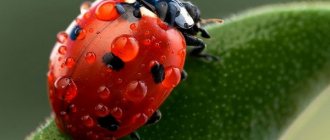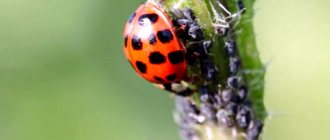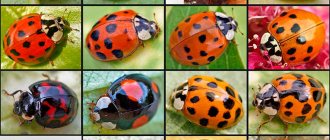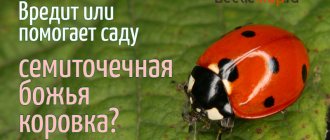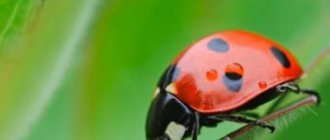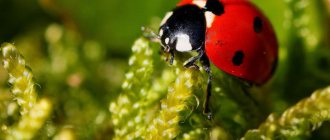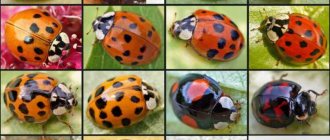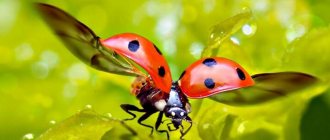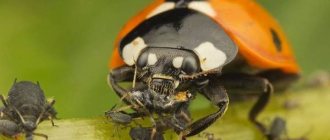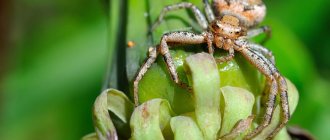Thanks to their bright colors, ladybugs are clearly visible on plants. These winged beetles endear children and adults with their appearance. They are often picked up to watch the businesslike running. At one moment the beetle spreads its wings and flies away. Where is he going? The insect has a lot of work, this cute creature is a ruthless predator that exterminates pests in gardens and vegetable gardens. The beetle feeds on phytophagous insects. Ladybugs and aphids are natural enemies. From spring to late autumn, spotted predators destroy aphid colonies.
How dangerous are aphids?
Aphids on cherries.
Under favorable conditions, the number of aphid colonies can increase very quickly. Because of this, the beds that are filled with a voracious family can be completely destroyed in a short time.
Aphids that have settled on the site pose a serious threat to young seedlings, bushes, trees, as well as indoor and outdoor flowers. It quickly spreads from one plant to neighboring ones.
Most often, this small pest causes damage to the following crops:
- cucumbers;
- tomatoes;
- currant;
- apple trees;
- plums;
- pears;
- roses;
- lilac;
- violets.
Beliefs
There are a lot of popular beliefs that are associated with these cute and very useful bugs, let’s get acquainted with the most popular ones:
- If a ladybug flew through the window into your apartment, or sat on you on the street, this is considered a very significant and good omen, you should expect pleasant events.
- When you find a “bug” in a web or in another difficult situation, you need to be as careful and attentive as possible, perhaps your enemies are trying to plot intrigues that could cause problems.
- People believe that butterflies and bugs are the embodiment of the souls of the dead. If you meet a “bug” in a cemetery, it means that one of the dead is worried about you and is protecting you in every possible way.
- The truly lucky ones get to see a ladybug clean its wings or wash itself. This action means that success and good luck await the person.
- Ladybugs have jaws, with which they easily cope with pests; they are not intended for biting humans. But they can all bite, and if this happens, people believe that this is a bad sign. A person needs to be careful, because the little bug wants to warn about troubles or enemies. You should not be afraid of the bites themselves, since they are absolutely safe for humans.
What is the relationship between ladybug and aphid?
Ladybugs are the real predators in the insect world. Their diet consists mainly of:
- scale insects;
- whiteflies;
- scale insects;
- small caterpillars;
- spider mites;
- aphids.
The latter is the most favorite delicacy of these red bugs, so it is they who destroy the bulk of the small pest in the beds.
It is worth noting that aphids are actively eaten not only by adult ladybirds, but also by their larvae. Therefore, the fact that the ladybug is the worst enemy of aphids is undeniable.
An example of larval relationships
The ladybug larva and the aphid are irreconcilable enemies. Its larvae eat aphids within 3-4 weeks. Then the larvae that emerge from the eggs actively feed on it. Over the course of its entire life, a ladybug eats about 8 thousand aphids.
Aphids can appear on different plants. On our portal we will tell you why this insect appears on orchids, peppers, cucumbers, currants and roses and how to deal with the pest.
How long ago did people start using ladybugs to fight aphids?
Ladybug Rodolia cardinalis.
Scientists first became interested in the diet of ladybugs back in the early 19th century. During this period, an Australian species of dangerous pest, the downy shield aphid, was accidentally introduced into North America.
Finding themselves in comfortable conditions, these small pests very quickly took over local citrus plantations and began to rapidly destroy the crop.
It was during this difficult time that the decision was made to use ladybugs to combat aphids, namely the species Rodolia cardinalis, which was also native to Australia. After 2 years of hard work by the “sun” bugs, the pest invasion was stopped.
Beetle helping gardeners
Ladybugs or Coccinellidae are a member of the beetle family whose main diet consists of aphids. In search of food, ladybugs migrate for the winter and return in the spring. In some way they are migratory insects. They are engaged in the extermination of aphids from spring to late autumn. After this, eggs are laid near the aphid colony.
Somewhere from 14 0C, ladybugs fill meadows, fields and other flowering and fragrant lands. Alfalfa and barley fields are the most pleasant for cows. These territories are so attractive for Coccinellidae because they are extremely attractive to the main nutritional unit of ladybugs, namely aphids.
During the larval stage, the ladybug consumes about a thousand aphids. In its adult state, an individual eats two hundred insects. Thus, the Ladybug is a farmer’s best friend, just as a dog is a man’s best friend.
How to attract aphids to your site
The diet of ladybugs contains not only other insects, but also pollen from various plants. To lure helpers to their plot, people began to plant those plants that most attract red bugs:
- cornflowers;
- calendula;
- geranium;
- dandelion;
- dill;
- coriander;
- mint;
- yarrow;
- fennel;
- series.
Also popular ways to attract such helpers is to use pheromone baits and independently populate the garden bed with bugs bought in a store or caught in other areas.
An interesting fact is that in the second half of the 20th century, the practice of dropping ladybugs onto fields from airplanes was widespread.
How to create the right conditions
You need to take a clean paper towel and fold it several times to create several layers. Next, moisten it in water and put it in the house. This sponge is an excellent source of water.
Regarding food, of course, the ladybug gives preference to aphids, but these pests cannot always be found for diet. Therefore, raisins soaked in water are placed in the house, as well as small pieces of cotton wool, which are moistened in sweet water.
Place wet moss on the bottom of the house. Remember that water is very important for these insects; if there is not enough of it, just like food, they can die.
Every day, water is sprayed into the house using a spray bottle. You should give pollen from the first plants that bloom, this could be coltsfoot. They also really love flowering willow, so you can pick a bouquet and put it in the water, and then treat the “ladies”.
Of course, it is quite difficult to provide ideal conditions so that they do not want to fly out into the wild. They love warmth very much, which signals that it is time to go free, so you should leave them in a room where the temperature does not exceed 15-17 °, and direct light should not fall on their house.
At temperatures above 20° they exhibit increased activity, which can be dangerous in captivity. In such conditions, the “ladies” begin to fly constantly, while hitting and falling, and may completely refuse food.
Large plastic or glass containers that have a lid are chosen as a house. You need to make small holes in the lid that will provide air access.
What types of ladybugs are the most dangerous in pest control?
The most common representative of the ladybug family in Russia is the seven-spotted ladybug. Children calmly caught bugs of this particular type with their hands and then released them “into the sky.” Despite their friendly nature, they are also predators and eat aphids.
Asian ladybug.
But, if we are talking about efficiency, then among the “ladies” there is one particularly aggressive species, which is considered much more voracious than the rest. This is the harlequin ladybug or Asian ladybug . In the last century, this species was specially bred in many countries to combat aphid infestations, and thanks to its “brutal” appetite, it coped with the task in just a couple of years. At the same time, the harlequin cow even exceeded the breeders' expectations, as it began to actively eat other insects, including beneficial ones.
Pests
Aphid (lat. Aphidoidea) is a small, sedentary insect, no more than 8 mm in length.
The only food for them is plant sap, which aphids extract by piercing a leaf or stem with their sharp proboscis and sucking it out. Many of them excrete sweet excrement or honeydew when feeding, because... They cannot digest sugar, which attracts ants. Read about the symbiosis of ants and aphids here.
Among aphids there are many species of insects that are carriers of dangerous viruses and bacteria.
They mainly live in dense, huge colonies, which are most often found in countries with tropical and mild climates. Aphids have learned to overwinter by laying their eggs in cracks in the bark, near the buds and in other secluded places. In each colony there are winged and wingless individuals, each of them plays its own role.
In the spring, wingless females emerge from the eggs and are able to reproduce without fertilization. These females immediately give birth to live larvae. And only by mid-summer do winged females appear. The lifespan of one generation is usually 10 days. Aphids can sit on one plant all their lives and feed on it due to their inactivity, until it finally dies (read about where aphids live and where they come from, read here, about what crops they attack and what the insect eats, find out here ). Their enemies are ladybugs.
Morphological description
The seven-spotted ladybug (Coccinellaseptempunctata) is a species found throughout Eurasia. This species is a frequent visitor to gardens and orchards. Insects live wherever there is food for them - aphid colonies. The body shape of the imago is half a sphere. Convex hard elytra of bright red color. The color is most intense in young adults; it fades with age. Black dots are distributed 3 on each of the elytra and one common one, located near the scutellum. The length of the adult is 7-8 mm.
Insects have evolved several defense mechanisms. In addition to their warning coloration, the cows pretend to be dead. They press their limbs to their body, fall and freeze. One of the ways to scare away the main enemies (spiders, large insects) is the release of a pungent-smelling liquid from the joints of the legs.
Spreading
Coccinellaseptempunctata is found in the steppe zone of Russia, Siberia, and Primorsky Krai. The insect lives in gardens and parks in Europe, Kazakhstan, Central Asia, Mongolia, China and Korea. A popular species distributed in India and North Africa.
About nutrition
Today, science knows more than 4 thousand species of ladybugs, and about 4 hundred of them are inhabitants of North America. In their absence, the garden would have to use strong chemicals that are unsafe for human health.
The process of spreading plant parasites is normalized by the appearance of beneficial beetles in gardens in early spring. Their interaction begins with the larval stage: the ladybug larva emerging from the egg has a voracious appetite and actively eats aphids, as well as their larvae, for 20 days. Then it pupates, and after 7-8 days an adult is born. The absence of a small plant parasite can be replaced by a whitefly or spider mite. The brightly colored bug can even eat caterpillars. That is why the spread of beetles from the air over crop plantations began to be practiced.
Aphids are a gardener's worst nightmare.
One of the main scourges of gardeners and gardeners is aphids. The main victims of this insect are young shoots of fruit trees and fruit bushes. He loves to settle on rosebuds, causing them irreparable harm. Having settled on cucumbers, it can lead to complete death of the plant. Aphids, settling on plants, feed on their juices, which, naturally, does not benefit them.
Aphids can also serve as carriers of pathogens of viral plant diseases. To combat this parasite, gardeners use chemical and biological products. It would seem that it would be easier to buy powder or concentrate in a specialized store. According to the instructions, I diluted it, sprayed it, and that was the end of the matter.
Currently, the market offers a wide range of drugs to combat aphids. They are safe for both people and animals. But it should be taken into account that when treated with such preparations, death also threatens other insects. Bumblebees, bees, and wasps may disappear from the garden. But without them, pollination is impossible. And these drugs are also unsafe for birds and fish.
Among other things, with this approach there are a number of rules that must be followed. To obtain the maximum effect when using an insecticide, you need to treat the plants either in the morning or in the evening. Spraying should be done in the absence of rain or wind. It is necessary to have a good sprayer on the sprayer. Take precautions using personal protective equipment. But you can do without chemistry. If a ladybug comes to the rescue.
Origin of the species and description
Ladybugs belong to the order Coleoptera or beetles. The Latin name for insects is Coccinellidae. The number of their species is more than 4 thousand, distributed throughout the world. The body has an oval convex shape similar to half a ball. It consists of three main sections: head, chest and abdomen.
In adult individuals, the fore wings are modified into hard elytra, and the hind wings are used for flight. The insect has 3 pairs of legs consisting of four segments. One of them is small and therefore invisible. The limbs are covered with hairs. The abdomen consists of 6 segments.
The usual color of the ladybug is red with black dots. Their number depends on the type of insect; it can be from 2 to 28 spots. In Russia and Europe, the seven-spotted ladybug is the most common. The beetle has 3 spots on each elytra and one in common. Body length 7-8 mm. The bright color is a warning signal for enemies who will try to eat the insect. When attacked, it releases a caustic yellow substance. This liquid can leave a burn on the mucous membranes of a reptile or bird. The coloring of different species of insects can differ radically; there are black ladybugs with red dots.
Beetles choose their place of residence depending on the nutritional preferences of the species. Some settle in trees in light forests, others in meadow grass, and others near water bodies. They are heat-loving insects that prefer temperate latitudes.
These beetles from the order Coleoptera are found in almost all climatic zones of the world. There are almost 4,000 species on the planet; 221 species of these insects live in our country alone.
The lifespan of a ladybug is 1 – 2 years. During this time, the insect goes through 4 stages:
- egg;
- larva;
- chrysalis;
- and imago - an adult insect.
Insects in winter
As already mentioned, they can winter in the place where they spend the summer, burying themselves in fallen leaves or hiding under the bark of trees. They can be found anywhere on earth except Antarctica.
They prefer green meadows, fragrant plants near water bodies, and green gardens. There are those who prefer to fly during the cold winter. They gather in groups and fly long distances, all in order to provide themselves with food.
The flights are made quite high and it will be very difficult for a person to notice them. Strong gusts of wind can become a strong obstacle on the way; they are forced to interrupt the flight and wait for favorable weather.
Plants that attract beneficial insects. ________________________________________
Tansy
It attracts ladybugs, cunning bugs, small parasitic wasps, lacewings and flies primarily due to its feeding value. The tansy aphid, for example, feeds on the sap of the plant and often accumulates in large numbers along the edges of its serrated leaves.
The advantage of tansy is that an infusion of tansy leaves repels the Colorado potato beetle. I’ll add on my own that abundant tansy herbage is good for use in composts. This compost does not harbor mole cricket and chafer larvae.
MOST READ FROM PARTNERS
Decoctions of tansy leaves and flowers contain many different vitamins and essential substances, improve the taste of kvass and dough, and jam is made from the flowers.
Chamomile
A perennial plant attractive to wasps and flies. During the flowering period it is covered with many yellow flowers.
Lemon marigolds
Attract small wasps and spiders. Seedlings are planted in the ground when the danger of frost has passed.
Caraway
MOST READ FROM PARTNERS
Attracts sly bugs, spiders, small wasps, hoverflies and lacewings during the flowering period. Its aromatic seeds are used in baking and for making marinades.
And also buckwheat, dill, honey plant, spearmint... And many have types of legumes, for example: crimson clover, creeping clover, vetch. They provide beneficial insects with constant food and moisture and enrich the soil with nitrogen.
To ensure the availability of flowering plants throughout the season that are attractive to beneficial insects, you need to start with those that bloom earlier, for example, with buckwheat, which will be replaced by fragrant dill. You should immediately plant marigolds and calendula so that they bloom in mid-summer. You should grow tansy, sweet clover and navel, which bloom for a long time from year to year.
The goal of using beneficial insects is not to completely destroy pests, but to control their numbers.
Harm from green aphids to apple trees
The main damage caused by apple aphids is as follows:
- decrease in yield;
- stopping the growth of new shoots;
- the appearance of sticky liquid on tree leaves, the appearance of red spots;
- curling and drying of leaves.
Signs of defeat
Fruit trees and shrubs should be periodically inspected for the following signs of aphid infestation:
- leaves covered with sticky liquid;
- leaf curl;
- curvature of buds, petioles;
- drying of shoots.
IMPORTANT. If there is at least one of these signs, then first of all they pay attention to young shoots, leaves, and non-woody places of old branches, since this is where aphids love to settle.
